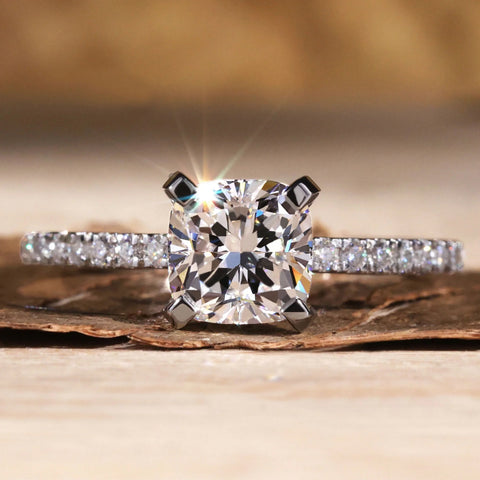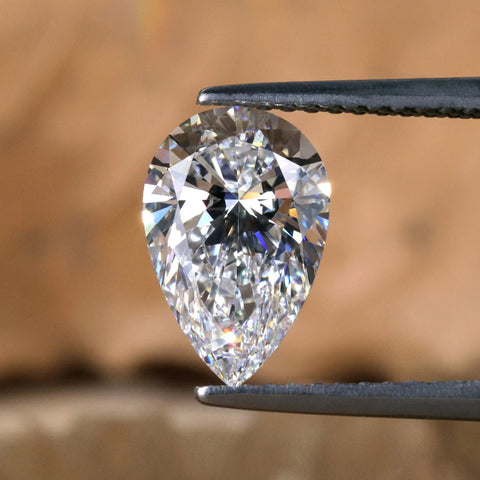
The Aesthetics of Moissanite and Lab Grown Diamonds: How Do They Compare to Mined Diamonds?
Table Of Contents
- Introduction
- What Is Moissanite?
- What Are The Benefits Of Moissanite?
- What Are Lab-Grown Diamonds?
- What Are The Benefits Of Lab Grown Diamonds?
- How Do Moissanite and Lab Grown Diamonds Compare to Mined Diamonds?
- Why Is Moissanite Or Lab Grown Diamond An Excellent Alternative For Diamond?
- Which One Is Right for You- Moissanite vs Diamond?
- Conclusion
Introduction
Moissanite was first discovered in 1893 in a meteorite crater in Arizona and is a naturally occurring mineral. It is often used as a diamond substitute due to its high refractive index and brightness and is now produced in a lab. Due to a slightly different appearance, Moissanite has a dissimilar crystal structure to diamond. It has a higher level of dispersion and more rainbow flashes of color than diamond, which means that when exposed to light it reflects more colors. Some people favor the pure white light that a diamond gives off while others favor the rainbow flashes of color that moissanite contains. lab-grown diamonds by using advanced technology that copies the conditions that diamonds form beneath the earth are made in a laboratory.
What Is Moissanite?
Moissanite, also known as space diamond due to its origin, is a gemstone discovered by Henry Moissan in 1893. These crystals were made of silicon carbide, and not carbon, such as diamonds. Hence the difference between moissanite and diamond side by side is clear, and the stone was also named after him.
Vintage 2 CT Portuguese Colorless Loose Moissanite for Engagement Ring
What Are The Benefits Of Moissanite?
Moissanite is a favored substitute for diamonds in other jewelry and engagement rings. Here are some advantages of moissanite:
- Affordability: Moissanite is notably cheaper than a diamond of the same quality and size. For those who want a beautiful, sparkly stone without breaking the bank this makes it a popular option.
- Durability: Ranking just below diamond on the Mohs scale of solidity, moissanite is one of the hardest minerals on Earth. It is a great choice for everyday wear because it is highly resistant to scratching and other several forms of damage.
- Brilliance: It is more brilliant and reflects more light because it has a higher refractive index than a diamond. This gives it a pretty, bold appearance that is highly prized by many people around the world.
- Sustainability: Moissanite has a much lower environmental impact than mining for natural diamonds because moissanite is a lab-created gemstone. Additionally, unlike some diamond mining activities, the production of moissanite is not connected to any conflicts or violations of human rights.
- Versatility: Moissanite is a versatile choice for any type of jewelry design as it can be cut into a variety of shapes and sizes. Additionally, it comes in a variety of colors, from traditional white to less common hues like green or pink.
What Are Lab-Grown Diamonds?
A diamond that has been created through a regulated technological procedure is known as a lab-grown diamond. Synthetic diamonds, as opposed to diamond simulants, are made of the same substance as naturally occurring diamonds, which are pure carbon crystallized in an isotropic 3D shape, and have the same chemical and physical properties.
1.50 CT Pear Cut Lab Grown Diamond, F/VS Lab Created Diamond for Engagement Ring
What Are The Benefits Of Lab Grown Diamonds?
lab grown diamonds are made in a laboratory setting through a process that duplicates the conditions under which natural diamonds are made and are also known as synthetic or cultured diamonds. Here are some advantages of lab-grown diamonds:
- Cost-Effective: The cost of lab-grown diamonds is typically lower than that of real diamonds. This is because they don't require mining or other expensive processes. After all, they can be made in a controlled environment.
- Ethical and Sustainable: Compared to natural diamonds lab grown diamonds are often considered a more sustainable and ethical option. They are not connected to the detrimental effects on the ecosystem and society that diamond mining may have.
- High-Quality: lab-grown diamonds vs real can be produced to the same standards as natural diamonds and are typical of high quality. They are graded using the same criteria and have the same physical and chemical properties as natural diamonds.
- Wide Range of Options: Consumers have a broad range of options when purchasing lab-grown diamonds because they come in a variety of colors, shapes, and sizes.
- Conflict-Free: lab-grown diamonds are considered conflict-free since they are created in a controlled environment. This indicates that they are not involved in the human rights violations that can take place in some areas where diamond extraction is common.
Overall, lab-grown diamonds offer consumers ethical, high-quality, cost-effective substitutes for natural diamonds.
How Do Moissanite and Lab Grown Diamonds Compare to Mined Diamonds?
In addition to having some parallels and differences with mined diamonds, two alternatives to mined diamonds are moissanite and lab-grown diamonds. Real diamonds, composed of the same substance and graded according to the same system as mined diamonds, are produced in laboratories. A less valuable and variously graded diamond substitute is moissanite. Mohs scale scores range from 9.25 for moissanite gemstones to 10 for lab-grown diamonds. Both points are great, which makes every stone a great option for everyday wear in engagement rings and fine jewelry.
 Elegant 4.13 TW Oval Rensu Cut Unique Three Stones Moissanite Engagement Ring
Elegant 4.13 TW Oval Rensu Cut Unique Three Stones Moissanite Engagement Ring
Most moissanite available today is lab-grown but moissanite is a naturally occurring mineral. With silicon carbide as its base material, It has a different chemical composition than diamonds. Moissanite sparkles more than diamonds because It has a different chemical composition than diamonds. However, it is more susceptible to scratching and damage over time because it is less hard than diamonds.
lab-grown diamonds are created in a laboratory rather than being mined from the earth and hence are chemically and physically identical to mined diamonds. They are produced by simulating the natural circumstances under which diamonds form underground in the earth. They are often less costly than mined diamonds but have the same hardness, brilliance, and fire.
When compared to mined diamonds, moissanite, and lab-grown diamonds are generally cheaper, making them a more economical option for those searching for a diamond-like gemstone. Since they are produced in a controlled laboratory atmosphere without the need for mining, they are also more environmentally friendly.
Some people may be able to tell the difference with a trained eye as both moissanite and lab-grown diamonds can be very similar to mined diamonds in terms of appearance. lab grown diamonds and moissanite frequently have more consistent appearances, whereas mined diamonds occasionally have distinctive inclusions or flaws that make them unique.
In the end, the decision to purchase a lab-grown diamond, moissanite, or a mined diamond will be based on your particular preferences, financial situation, and values.
Why Is Moissanite Or Lab Grown Diamond An Excellent Alternative For Diamond?
For several factors, moissanite and lab-grown diamonds are superior to natural diamonds.
- Affordability: Natural diamonds are much more expensive than moissanite and lab-grown diamonds vs real. They can be up to 90% less expensive, making them a more affordable choice.
- Ethical and environmentally friendly: moissanite and lab-grown diamonds vs real are ethical and environmentally-friendly options, unlike natural diamonds which are often mined in conflict zones and can contribute to environmental damage. Moissanite is a naturally occurring mineral while lab-grown diamonds are created in a controlled environment without the need for mining.
- Durability: Both lab-grown diamonds and moissanite are incredibly strong and scratch-resistant, making them perfect for everyday wear. They sparkle just as much as real diamonds thanks to their high refractive index.
- Availability: Since there are a limited number of natural diamonds, finding the most coveted diamonds can be challenging. Contrarily, customers have more access to moissanite and lab-grown diamonds because they are widely accessible and come in a variety of shapes, sizes, and colors.
Overall, lab-grown diamonds vs moissanite offer an affordable, high-quality, and moral substitute to natural diamonds, making them the best choice for those eyeing a beautiful and sustainable substitute.
 1.20 CT Cushion Cut Engagement Ring, Lab Grown Cushion Diamond Ring
1.20 CT Cushion Cut Engagement Ring, Lab Grown Cushion Diamond Ring
Which One Is Right for You- Moissanite vs Diamond?
Real diamonds, composed of the same substance and graded according to the same system as mined diamonds, are produced in laboratories. A less valuable and variously graded diamond substitute is moissanite.
Your personal preferences and financial constraints will eventually determine whether you choose moissanite vs diamond. Here are some things to think about while comparing lab diamonds vs diamonds:
- Cost: Moissanite may be the best option if budget is a major factor for you as lab-grown diamonds are usually less expensive than natural diamonds, while moissanite is even less expensive than lab-grown diamonds.
- Durability: Moissanite and lab-grown diamonds both have a high degree of durability. However, because they are less likely to chip or scratch than moissanite, lab-grown diamonds are still regarded as the more resilient choice.
- Brilliance and Fire: moissanite reflects more light and appears more sparkly because it has a higher refractive index, both lab-grown diamonds and moissanite are named for their high excellence and fire.
- Ethics and Sustainability: Because they do not add to problems like conflict diamonds or environmental damage brought on by diamond mining, lab-grown diamonds are frequently regarded as a more moral and environmentally responsible alternative to natural diamonds. As it is produced in a facility rather than through mining, moissanite is another environmentally friendly choice.
Overall, when choosing between lab diamond vs diamond it's important to weigh your priorities. Moissanite may be the best choice if you're looking for a more affordable option with high excellence. lab grown diamonds may be the better option for you if you prioritize durability and sustainability.
Conclusion
As substitutes for mined diamonds, moissanite and lab-grown diamonds have increased in popularity recently. Both moissanite and lab-grown diamonds have several benefits over mined diamonds in terms of aesthetics. For instance, Moissanite has more fire and brilliance than diamonds because it has a greater refractive index. Additionally, it comes in bigger sizes and is less expensive than diamonds that are mined. In contrast, the molecular makeup and physical characteristics of lab-grown diamonds are remarkably similar to those of naturally occurring diamonds. As they are not linked to problems like violations of human rights, environmental degradation, or unethical mining practices, they are frequently less costly than mined diamonds and are also more ethical and sustainable. Hope this guide is useful to you guys. For more details visit our website Diamondrensu.
Leave a comment
Please note, comments must be approved before they are published.











